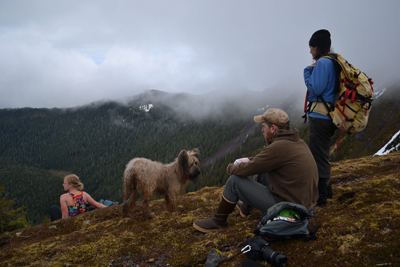Highest elevation 3,201 ft (975.7 m) Max length 38.6 km Island group Alexander Archipelago | Highest point Mt. Edgecumbe Area 433.8 km² Max width 14.5 km | |
 | ||
Three brown bear cubs at fred s creek kruzof island ak
Kruzof Island is an island in the Alexander Archipelago in southeastern Alaska at 57°10′14″N 135°40′29″W. It is about 16 km (10 mi) west of Sitka, and is part of the City and Borough of Sitka. It was named in 1805 by Captain U.T. Lisianski as Crooze Island, after a Russian Admiral. In January 1813 the Russian exploration ship Neva wrecked just off the island. The survivors made it to shore and established a camp where they subsisted until rescued about a month later. The site of the wreck, and also the survival camp has since been found.
Contents
- Three brown bear cubs at fred s creek kruzof island ak
- Map of Kruzof Island Sitka AK USA
- Wwii on kruzof island
- Naming history
- Geography
- Human importance
- References
Map of Kruzof Island, Sitka, AK, USA
In 1849, Captain Tebenkov recorded the Tlingit name for the island as being Tlikh.
Wwii on kruzof island
Naming history
Before being named by Lisianski, it was called San Jacinto after Mt Edgecumbe was named Montaña de San Jacinto by Don Juan de la Bodega y Quadra in 1775. La Perousé referred to that name by calling the island St. Hyacinthe. Captain Nathaniel Portlock named the island Pitt Island in 1787. Early Russian traders called it Sitka Island. In 1849, Constantin Grewingk called the island Edgecumbe.
Geography
The island is 37 km (23 mi) long and 13 km (8.1 mi) wide with a land area of 167.47 sq mi (433.7 km2), making it the 41st largest island in the United States. The island is formed in part by Mount Edgecumbe, a small dormant stratovolcano and several cones and collapsed cones that make up its volcanic field.
Human importance
It does not have a permanent resident population. There is a maintained trail leading from Fred's Creek cabin, a USFS cabin on the inside coast, to the summit of Mt. Edgecumbe, as well as several trails across the island.
Kalinin Bay, on the northern shore of the island, provided the name for the World War II warship USS Kalinin Bay. From the 1950s through the 1970s, forests on Kruzof Island were the source for clearcut timber extraction.
